

|
Back to |
| The Front Page |
| Letters & Opinion |
|
Plus Twenty Six and All That A Prehistory of Croquet (including Inaccuracies) by Laurence Latham Illustrations by Deborah Latham posted July 12, 2013
|
||||||||
|
||||||||
When Walter Carruthers Sellar and Robert Julian Yeatman wrote 1066 And All That, their highly acclaimed 1930 satire upon textbook history, they unaccountably chose to omit any reference to the influence which Croquet may have had upon the development of Britain. For the benefit of those with an interest in the game, the following article attempts to redress that oversight, while paying tribute to their innovative style. Although a thorough knowledge of British history would be a useful prerequisite for fully appreciating certain aspects of the account (and therefore a Good Thing), it is by no means essential for comprehension. Readers without such advantage should not therefore be dissuaded from perusal of the piece.
Of Monolith and Megalawn
Croquet first gained popularity in Britain during the Stone Age, despite the equipment having to be fashioned from the only material then widely available. The standard set contained flat-pack hoops, each of which came as three mini-monoliths requiring self-assembly. This did not pose the problem it might do today because, since no-one could write, unintelligible instructions were not included.
The main stumbling block (apart from the occasional collapsed hoop) was the distinct shortage of experienced referees, nobody having a great deal of history to draw upon. In an effort to reduce errors and arguments an ambitious plan was hatched, entailing the construction of a vast croquet court on Salisbury Plain, large enough to be viewed from the heavens.
Unfortunately, before the levelling programme could begin, the chosen contractor went into liquidation, with the result that the enormous hoops were left dumped in a circle while everyone ran round forming committees in an effort to decide the best way forward.
Difference of opinion between the various working groups grew to such an extent that it led to the fragmentation of society, with each faction separating itself and establishing its own close-knit community. Their encampments were often fortified with some of the many huge bisques which had also been left over from the original project and which would otherwise have simply gone to waste. This idea was so popular that using the design of the oversize bisque as the basic unit of perimeter fortification remained in vogue for many generations.
The only exceptions to these encampments were created by members from the committee which had been set up specifically to deal with the issue of Boundary Lines. These individuals eschewed the idea of fortification and instead founded the original Linear Settlements.
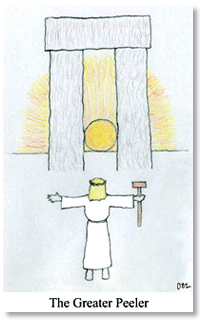
|
Saxons and Danes
The standard of play reached new heights during the Saxon period. This was in no small part due to a general increase in the accuracy of the croquet stroke itself, as most players came to terms with the Angles. Not long afterwards the game began to attract royal followers, with a number of English monarchs each making a contribution to its history, though not always with positive results.
Despite being a great player, Alfredís disastrous attempt to assist with the teas almost resulted in the burning down of a clubhouse. This led not only to a ban on any future king putting his name on the catering roster, but also to a substantial rise in the price of cake, which did not go down well among members of the proletariat.
Around two hundred years later Ethelred II appeared on the scene. Much to the irritation of more than a few managers, he would habitually mislay either his waterproofs or his mallet, thereby frequently rendering himself Unready when play was due to start.

|
It should perhaps be noted in passing that the widely held belief that Vikings wore horned helmets remains for the most part erroneous, for the vast majority of invaders did not. It was only those arriving with an eye to croquet who developed this habit, since the addition of horns provided a most convenient place to attach any clip which needed to be carried during the making of a break. It is thought that this development also led to the introduction of the ring doughnut, which could similarly be carried, thus obviating the necessity of them stopping for light refreshments.
Down Senlac Hill to Agincourt
In 1066 (which date is chiefly remembered due to the recognition it was afforded by W C Sellar and R J Yeatman in their 1930 publication 1066 and All That), a foreign gentleman called Norman realized that winning the Championship of England would most likely be a doddle for a competitor of his calibre, especially since his main rival, Harold II, had recently expended much energy getting rid of his own namesake, Harold the Handicapper, in order to ensure open play. With this in mind, Norman travelled over for the forthcoming tournament at Senlac Hill near Hastings, where, in a cunning effort to outwit his opponents, he entered under the pseudonym of William. There followed an appalling disagreement in the clubhouse, which is said to have ended with Harold getting a bisque in the eye.
Nevertheless, the competition went ahead, but William, perhaps falling back into the tactics of his great aunt Emma, almost failed to win the title. Once more he had to resort to subterfuge and, knowing the English had one great weakness, organized the ringing of a spurious bell which sent his opponentís supporters charging off towards the tearoom, amid much clattering of folding chairs, at an inopportune moment. William thus wrested the title from Harold and by dint of this achievement subsequently became known as William the Conqueror, except by those who were aware of the incidents involving the bisque and the bell, and who, as a result, called him something quite different.
In due course, and in a further effort to stamp his persona on the game, William endeavoured to introduce the Norman hoop. Characterized by its rounded top, the idea was never popular and predictably failed to catch on.
Thereafter things went badly for the rest of the family, too. William II might have become a more successful competitor had it not been for his complete inability to play with blue and black. When winning the toss he would always choose red (and yellow), thus earning himself the nickname Rufus. His career was brought to an abrupt end by an accident when shooting at the peg.
His younger brother, Henry I, also found his tournament-playing days curtailed after he was disqualified for helping himself, in blatant contravention of the Regulations for Tournaments, to a surfeit of bisques.
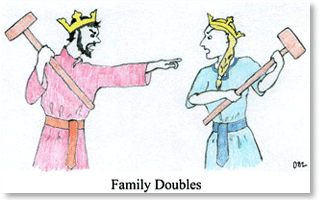
|
Within half a century, however, King John encouraged a revival, though his mind tended to dwell a little too much on what refreshments were in the offing. Afraid lest he be caught impecunious at the arrival of the coffee trolley or the ringing of the lunch bell, he took to carrying an inordinate amount of coinage around with him on court. One day he evidently forgot to transfer it when changing after play and, as a result, lost the lot when his whites went into the Wash.
Two hundred years after Johnís monetary misfortune, Henry V played magnificently on the famous Agincourt, where the croquet connection is sometimes forgotten. This is because the French pronounce the name without any tea, which, unlike the English, they donít particularly enjoy. Henryís unexpected win is often credited to the Archers, and with good reason. Not due to start a potentially lengthy match until 1415 and fearful of missing the evening episode, he played with great expedition to snatch a swift and decisive victory.
Introducing the Ladies
In the early sixteenth century wives were very popular and Henry VIII had half a dozen of them. This he soon found to be a bad idea, their residence at Hampton only having one Court, which his other-sevenths had a tendency to hog for doubles, thereby leaving him on the sidelines.
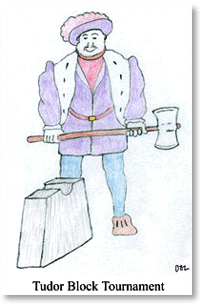
|
In spite of this, the event set a precedent and it was soon decided to hold a Ladiesí Championship, albeit with only three entries. Jane was quickly eliminated but the other two were soon engaged in a right old tussle, the initial success of Mary I soon giving way to the persisting dominance of Elizabeth I. Indeed, once in possession of the title, Elizabeth ensured that the event was discontinued and even cast doubt on the future of the Championship itself. Overseas competitors were banned, and whilst Spanish players campaigned to overturn this, each of their attempts at entry was met with a stormy reception.
Eventually Elizabeth relented so far as to allow admission to the Scots, who hitherto had steered well clear of croquet. This is likely to have been because they saw the Mallet as undesirably akin to the Hammer, with which they had had a bad experience during the reign of Edward I. Nonetheless, unlikely an outcome as it may at first have seemed, it was a Scot who took the title. His name was James and his handicap was hurriedly reduced from six to one.
Feud, Fire and Fruit
Predictably, in due course this dominance on the part of the monarchy caused unrest and was eventually challenged by Oliver Cromwell, who rebelled against London remaining as the focus of attention. He insisted that major tournaments should instead be held in Norfolk, which, he argued, was very flat and thus eminently more suitable. His followers also attempted to rebel against the status quo by reintroducing the Norman hoop, thereby earning themselves the name of Roundheads. This was a step too far and support for these revolutionary ideas waned rapidly, especially after Oliverís son Richard took over the Chairmanship of the Tournament Committee. In less than ten years play once again became centred on the capital.
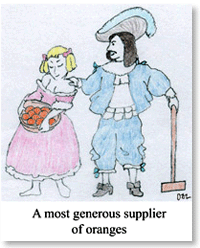
|
While there ensued much speculation over the identity of the perpetrator, Charles II himself could immediately be excluded from the list of suspects. Thanks to the shenanigans of his forebear, Alfred, almost eight hundred years earlier, he clearly could have had nothing to do with the actual catering, although, not long afterwards, it is thought he did become a most generous supplier of oranges to the club.
A Rough Passage from Medway to Boston
More problems arose in 1667 when a host of Dutch players attempted to take over the courts at Medway. Apparently, they were still lamenting the loss of their own lovely level lawns back in Holland, where, shockingly, these had been dug up by profit-oriented tulip growers three decades earlier.
Within another quarter of a century, there arose an upsurge in the esteem of doubles play, the cause now being largely championed by the patronage of William III and Mary II. Regrettably, however, another opportunity was wasted. The renewed interest was short-lived, the initial enthusiasm fading swiftly upon Williamís insistence that it become de rigueur for participants to compete in Orange.
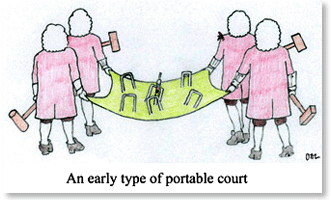
|
All went reasonably well until George III let his corner down, paving the way for the introduction of American Rules. Once again this was in large measure due to that perennial British Achilles' heel, tea. Wanting to keep the best for clubhouse refreshments, George sent a rather cheap brand over to the Americans in the hope that they wouldnít notice. Unfortunately, they did, and, in an effort to finish it up quickly, tried to make it all at once, using water from Boston harbour.
When George learnt what had happened he was furious, being of firm belief that things should, of course, have been done the other way round, with the harbour water being added to the tea. This sadly led to a number of Intolerable Acts on the part of the British, the differences became irreconcilable, and the nine inch yard-line was born.
Towards the Modern Era
By about 1850 the pre-history of croquet may be considered as having come to an end, thereby making way for the early stages of the modern game and the entrance of Walter Jones Whitmore.
Those wishing either to discover or to remind themselves how this extraordinary individual had not only reorganized his names but also turned his attention from Squails and Frogs and Toads, via a railway Carriage Signal utilizing gunpowder, a Focus Shade and a Bootlace Winder, to formulating the Rules of Croquet, must refer to the genuinely enlightening and fascinating pages of The History of Croquet by D M C Prichard.
Despite having had the privilege of being taught during his earlier years by the highly respected historian and author David James Cathcart King, Laurence Latham regrettably went on to fail O-Level History in 1966. For someone of British extraction, his own tea-drinking habits have been rather unusual. For a considerable time he limited consumption to one cup per year, only ever to be taken at Sidmouth, a select seaside town and most agreeable croquet venue situated on the south Devonshire coast. In 2002, however, this annual intake was inadvertently doubled; coincidentally, he has never played there since. As a consequence, he has not taken tea for well over a decade.